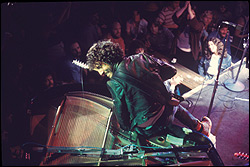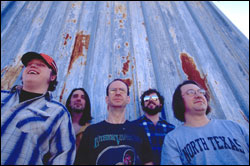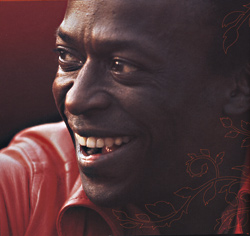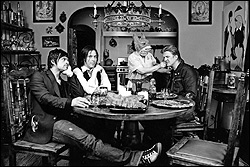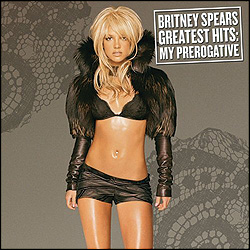Born to Run is the greatest rock musical of the ’70s. History may have typecast Bruce Springsteen as a neo-trad revivalist flicking the house lights up to dispel the glam artifice of Bowie and Elton, but in 1975 his idea of good ol’ rock and roll staggered toward the brink of eccentricity. The opening harmonica wheeze of “Thunder Road” is more Oklahoma! than Okie; the bluesless piano that climaxes the nine-and-a-half-minute soap-opera finale “Jungleland” ain’t hardly the news Chuck Berry wanted Tchaikovsky to dig. And as with so much canon fodder—London Calling and Sgt. Pepper’s come to mind—what falls between is weirder and wilder than its accumulated encomiums ever imagine.
For sweep, for uplift, for (above all) believability, no arena thespian topped Bruce. The real American theater, he implied, wasn’t a scripted institution—hucksters improvised its dialogue on boardwalks and midways, relieving willing dupes of disbelief at a nickel per. Rather than stiffly mimic stale Broadway usages, Springsteen reclaimed rock and roll’s own theatrical tradition, rooted in the pre-Beatles ’60s: the operatic yearning of Roy Orbison, the urban symphonies of Phil Spector, and (rocking enough by association) the jazzy bustle of West Side Story. Reissued with a sharp remaster undiluted by bonus tracks, an adequate mini-documentary, Wings to Wheels, and a DVD of Bruce’s fabled Hammersmith Odeon performance, Born to Run: 30th Anniversary Edition (Columbia/Legacy) stands as so complete a culmination of this vision that Springsteen would never again attempt anything of its lunatic scale.
Born to Run is a creaky fun house of clichés distended and distorted, debunked and metastasized. The hopeful “Thunder Road” and the hopeless “Backstreets” reject threadbare secondhand romanticism only to cloak themselves in even grander, more sprawling delusions. In the former, Springsteen links his would-be sweetie’s private longing for true love with the empty rituals of religious devotion, but as earthy as the “redemption” he offers in its stead may be—”a chance to make it good somehow”—his own muscular faith rings even more hungrily idealistic. And in the latter, two young lovers fuel their shared self- importance with cheap B-movie pessimism, until she splits and he resigns himself to the crushing banality of real heartbreak and the discovery that “we’re just like all the rest” with a gargantuan sigh of despondence.
Each aching response to “Will You Love Me Tomorrow?” that Springsteen bellows could spark an eye roll from the most jittery Shirelle, let alone the tough gals of “Be My Baby” and “He’s a Rebel,” whose dreamboat ideal he hoped to embody. Sure, his refusal to hit the road without his baby refreshed the folkloric travelin’-man motif that had curdled into the triumphant outlaw chauvinism of the Eagles. It also smacked as much of desperation as chivalry. Being Bruce Springsteen was hard work—audibly so, as his labored (though more flexible than you remember) Orbisonic vibrato suggested the hours of frustrated hair-combing and the mounds of rejected outfits no coolly posturing street kid would ever cop to. The charm of the bloated Scorsese-lite of “Meeting Across the River” and the umptillion-tracked Bo Diddley travesty “She’s the One” is that they can’t help but try too hard.
Fittingly, the extras here strive mightily to show us how mightily Springsteen did strive. Though often as puffy as any artist-approved documentary, Wings to Wheels justifies itself with an earful of Born to Run work tapes— an even more intricate “Jungleland” and, especially, a chorale-inflated “Born to Run”—that makes me wish, for once, for a full disc of outtakes. It also reminds me that though Bruce’s busy arrangements do indeed tilt toward the bleached calisthenics of prog, their careful choreography is the precise opposite of the let-‘er-rip jam ethos. The DVD, I admit, worried me some. Springsteen’s ’75 London stand was the stuff of legend—Peter Gabriel claimed it inspired him to quit Genesis and write “Solsbury Hill”—and I edged as warily toward potential disillusionment as I had with the Star Wars prequels. But if the sad reality of Ewan McGregor battling computer-generated puppetry amidst failed interstellar trade negotiations had deflated my childhood expectations, the sight of this scraggly surf rat searching underneath the stage for his lost ski cap during “Spirit in the Night” surpassed them.
The message of the rapturous “Thunder Road” and “Born to Run”—trust me—echoes the demands of good faith that every wily con man with a cure-all or sweet-talking guy with a hard-on—or, for that matter, every artist with an idiosyncratic reflection of reality—relies upon implicitly. In the mid-’70s, just a bridge and tunnel away from Bruce’s Asbury Park, punks sought to reconcile their arty smarts with their love of the same cornball heart of rock and roll. Blondie and the Ramones tweaked the infatuation to which they never quite surrendered with fond irony, Jersey girl Patti Smith defied you to disprove that her three chords cut to the incantatory heart of existence. But Bruce wanted it both ways, and not for nothin’ did he name his most famous heroine Wendy. Born to Run offers a one-way ticket to a Neverland he can’t bring himself to not believe in, all the while whispering, Hell, you gotta believe in something. Why not this?
